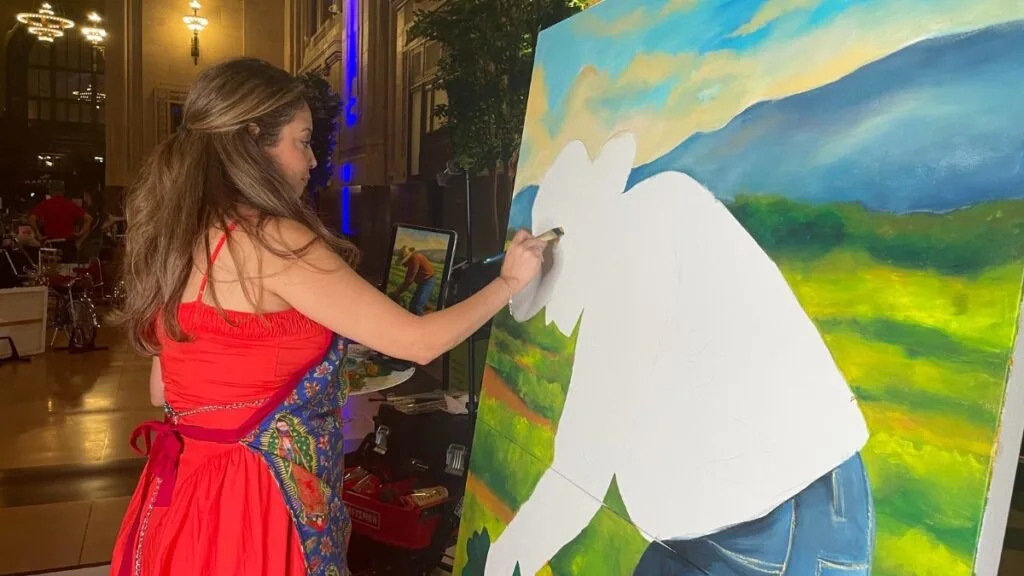
The finished artwork of Vania Soto is being sent to Washington, D.C., to become part of a traveling exhibit of the National Museum of the American Latino. Soto wanted her painting to honor farmworkers and began the piece during an Aug. 9 community storytelling event held at Union Station (Mary Sanchez/ The Beacon).
For more than 30 years, the vision has been clear.
A museum dedicated to Latino history will someday take its place alongside other Smithsonian Institution buildings in Washington, D.C.
Groundbreaking is likely still years in the future.
The National Museum of the American Latino has deep connections to Kansas City, a fact that helped draw national staff to the area in early August for community events.
Discussions were wide-ranging.
People spoke about painful memories of discrimination, like the segregated schools that once existed for Mexican children, and other challenges.
Yet deep pride was on full display for the accomplishments of local heroes in business, education and the arts. Attendees praised the patriotism of Latino veterans. They expressed a strong belief in the nation’s opportunities, long embraced by immigrants.
“We’re writing our own story so that others can see how we fit into the American experience,” said Ramon Murguía, a Harvard-educated lawyer, trustee of the W.K. Kellogg Foundation and Kansas City area philanthropic leader often cited for his role in helping to raise millions of dollars in scholarships for college-bound area youth.
Museum proponents are keenly aware of the need to continue building bipartisan support to weather current culture wars, including President Donald Trump’s recent decision to vet some exhibits and museums of the Smithsonian Institution.
Shortly after the museum staff left Kansas City, the Latino museum found itself in the White House crosshairs on Aug. 21, flagged several times in a listing of Smithsonian exhibits and messaging criticized as woke or anti-American.
Murguía sees the development of the museum as a marker of respect.
He wants it to honor the contributions of Latinos in building the wealth of the nation, often through their strenuous labor working on railroads, in packing houses and increasingly as an engine of entrepreneurship.
The museum can also counter the false impression that Latinos are primarily recent immigrants, he said.
“We are instrumental to the development of this country,” Murguía said.
Jorge Zamanillo, the Latino museum’s founding director, joined Murguía in an Aug. 8 fireside chat at Kansas City’s Union Station.
People assume that the better-known heroes will be represented at historical institutions, Zamanillo said. But he said the essence of any museum, the guiding narratives, is made up of individual, very personal stories.
“How do we illuminate those local stories so that they resonate at the national level?” Zamanillo said.
The morning event, dubbed Cafecito con Jorge, was attended by a wide range of business and civic leaders, including the Mexican Consul Soileh Padilla Mayer and the director and CEO of the Nelson-Atkins Museum of Art, Julián Zugazagoitia.
The mammoth nature of the project loomed over the conversation.
The challenge is to fairly and accurately curate artifacts and exhibitions to tell the stories of the nation’s 64 million Latinos, who can trace their diverse cultures and histories to countries around the world, encompassing every race.
That history goes back 500 years, before the nation’s founding, and must include indigenous people and the narratives of U.S. territories, such as Puerto Rico.
Latino history is American history
A guiding principle of the decades-long quest to establish the museum is that Latino history is American history.
The National Museum of the American Latino was authorized by Congress in 2020 and signed into law by Trump during his first term.
Still, it has a long way to go before construction can begin.
Supporters plan to continue nurturing the strong bipartisan support the project has long enjoyed — some of it through the work of Kansas City-area leaders.
The most recent hurdle is Trump’s efforts to influence how American history is presented in government-funded museums.
A White House letter released Aug. 21 was titled “President Trump Is Right About The Smithsonian.”
An animation video about the diversity of disabled Latinos was listed for including “a disabled, plus-sized actress” and an “ambulatory wheelchair user” who “educates on their identity being Latinx, LGBTQ+, and disabled.”
It also criticized messaging about the Mexican-American War framed as “the North American invasion” that was “unprovoked and motivated by pro-slavery politicians.”
Trump also backed budget cuts to eliminate dedicated funds for a standalone Latino museum, possibly relegating it to being a center within the Smithsonian’s network of 21 museums.
The change has drawn bipartisan pushback, with groups representing both Democrats and Republicans continuing to press for a separate museum for Latinos.
In recent years, progress has been made to establish two new Smithsonian museums — one for the American Latino and another American Women’s History Museum.
The politicization of the Smithsonian’s holdings and messaging has made some aspects of the work tough in recent months, Zamanillo acknowledged.
“We need to make sure that we’re not a part of that,” Zamanillo said, “and make sure our stories are elevated and we have strong support.”
Museum staff spent several days in the Kansas City area meeting with teachers, civic leaders and community members.
Next steps will be to continue gathering stories, begin collecting artifacts, cataloging oral histories and shaping themes from the feedback.
Building interest is also deeply tied to fundraising. Small donations under $30 can be a part of charter member status.
A similar focus helped draw broad support for the National Museum of African American History and Culture, which opened in 2016.
Black veterans of the Civil War first proposed an African American museum in 1915. Congress approved construction of a memorial in 1929, but with the stipulation that private funds needed to be used. It took until 2003 before the museum was established as part of the Smithsonian by Congress.
In 2022, the Molina Family Latino Gallery opened within the Smithsonian’s National Museum of American History. The gallery is a 4,500-square-foot space.
The far larger Latino museum is projected to cost more than $1 billion, partially based on what it cost to build the African American museum, Zamanillo said.
Half of that money will need to be raised through corporate grants, foundations and individual donors. Nearly $72 million has been raised in the last three years, Zamanillo said.
The other half can come through appropriations, he said.
Nearly 30 locations on and off the National Mall were researched as a possible location for the museum, Zamanillo said. Congressional approval is necessary to place the building on National Park Service property.
A preferred proposal would see it built in the Tidal Basin area, which is part of the National Mall and Memorial Parks.
Nurturing bipartisan support for Latino history
Shortly after taking office, Trump issued an executive order dubbed Restoring Truth in American History.
The intention of the order was to “eliminate improper, divisive or anti-American ideology from the Smithsonian and its museums, education and research centers, and the National Zoo.”
Follow-up actions such as an Aug. 12 letter ordering a review of Smithsonian holdings, have drawn sharp criticism from archivists, historians and free-speech experts.
Many see it as an attempt to reframe the nation’s history to make it more palatable to Trump’s interpretation of patriotism and an appropriate framing for retelling the nation’s history ahead of the country’s 250th anniversary.
The fear of some is that significant events of American history will be downplayed or eliminated, such as civil rights struggles and periods of deep racial division.
Differing opinions on how history is displayed are endemic to curating.
For the nation’s Latinos, criticism has come in the past from conservative views that were displeased by an emphasis on socialism and portrayals of the community as victims.
Still, the Latino museum, even when it was a concept, has long enjoyed bipartisan support.
CiCi Rojas is board chair of the Friends of the National Museum of the American Latino, formed in 2005 to build support for the museum.
Rojas is president and co-founder of Tico Productions and Tico Sports, a multimedia marketing agency and a provider of Spanish language broadcasts of professional sports teams, including the Kansas City Chiefs and many other NFL teams.
“The campaign has always been rooted in bipartisanship,” Rojas said.
Rojas traces that support through the history of the museum.
In 2003, legislation to authorize a commission to study the feasibility of a Latino museum was introduced by then-U.S. Reps. Ileana Ros-Lehtinen, a Florida Republican, and Xavier Becerra, a California Democrat.
President George W. Bush signed the law creating the 23-member commission.
President Barack Obama was in office when the commission’s 136-page report was finalized in 2011.
Trump, during his first term, signed the National Museum of the American Latino Act, which authorized a new museum of the Smithsonian.
More recent examples of bipartisan support came in the form of letters to congressional appropriations committees.
In June, the Democrat-led Congressional Hispanic Caucus rejected a “scaled down” Latino center instead of a brick-and-mortar permanent Smithsonian building on the National Mall.
“Latinos make up nearly 20% of the U.S. population and have shaped every facet of our national story — from military service and labor rights to music, science, and art,” the letter reads. “A permanent, brick-and-mortar institution is the only appropriate way to recognize this legacy.”
The Republican-led Congressional Hispanic Conference letter also strongly urged funding for the separate museum, saying anything less is “unacceptable.”
The conference letter also called for proactive steps to ensure the Latino museum “remains unbiased.”
“This museum was authorized through the leadership of President Trump during his first term; now, under his renewed leadership, we have the opportunity to finish the job and deliver on this historic investment that will educate and inspire Americans for generations to come,” the conference letter said.
Combined, the bipartisan messaging is emblematic of the wide support the museum has long garnered, Rojas said.
“This idea to present a more complete story of U.S. history transcends politics and ideologies,” Rojas said. “We remain committed to seeing it through to fruition.”
This article first appeared on Beacon: Kansas City and is republished here under a Creative Commons Attribution-NoDerivatives 4.0 International License.


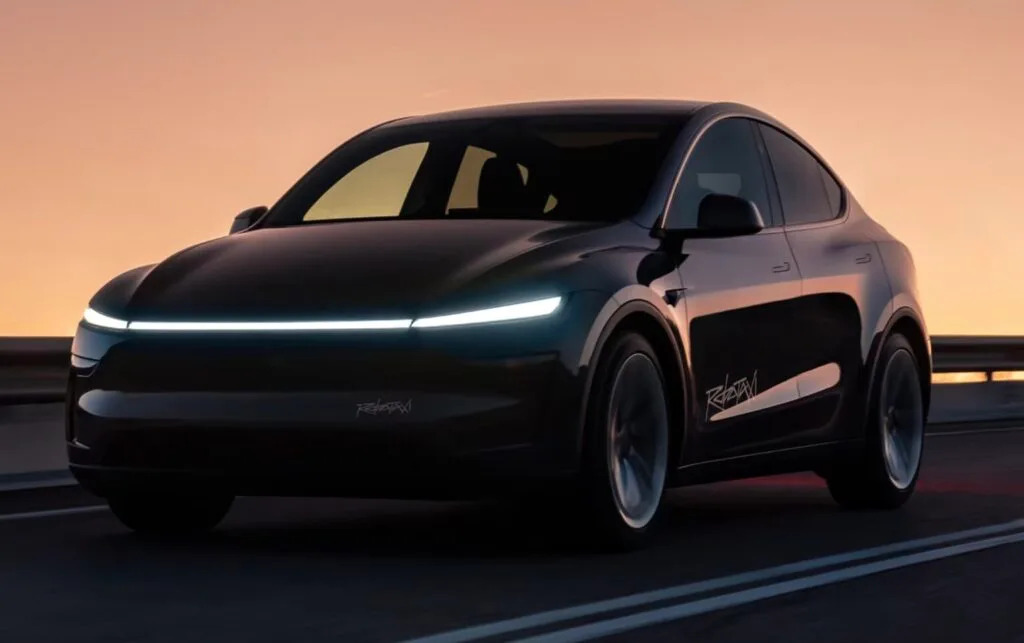
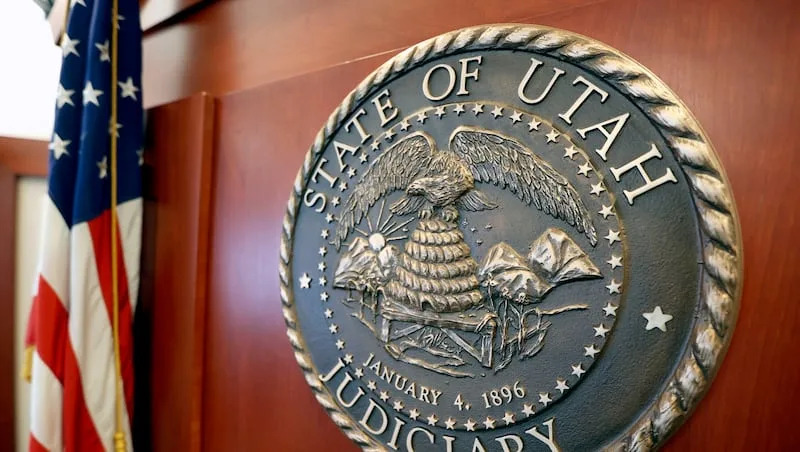
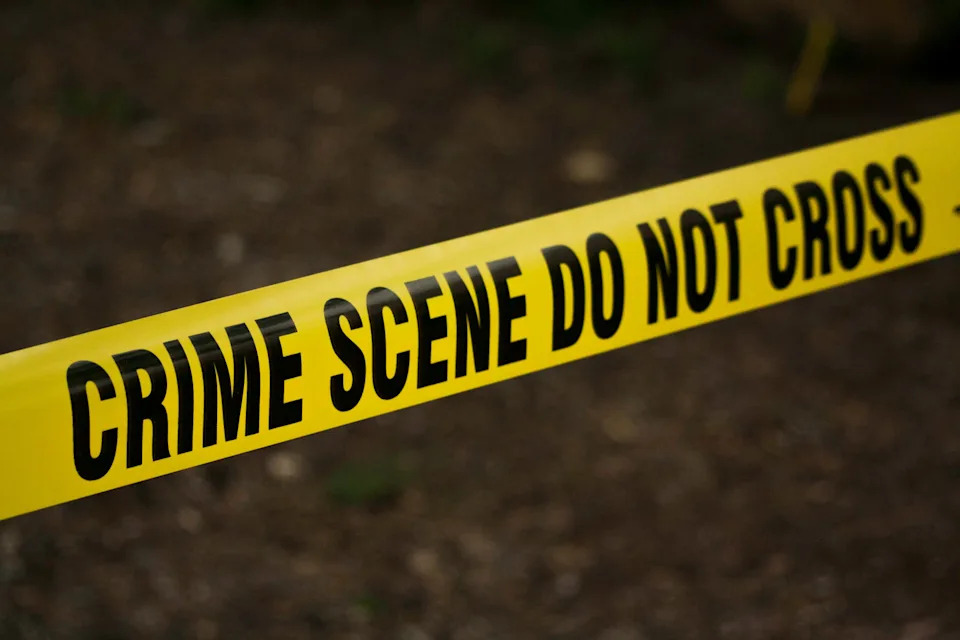



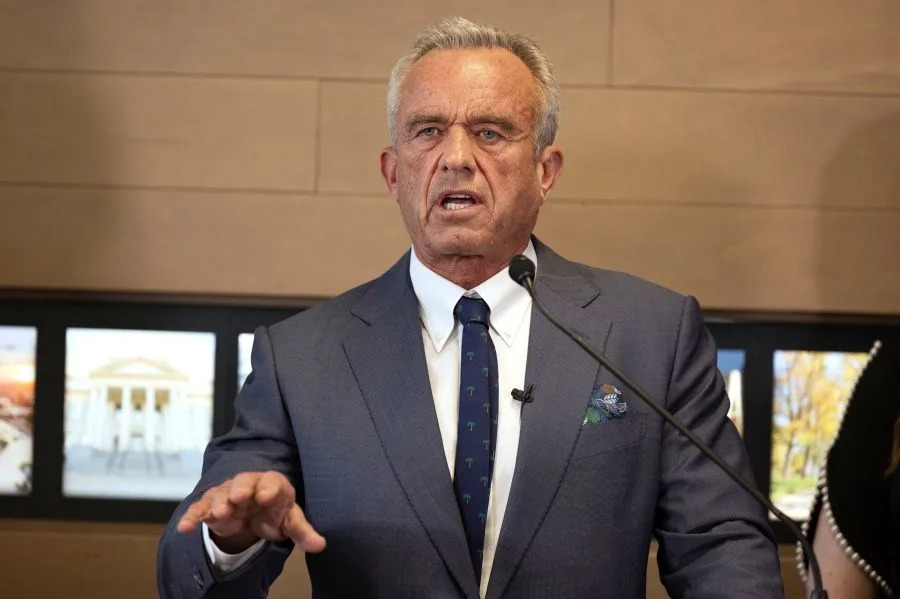
Comments